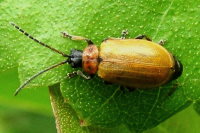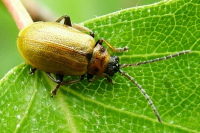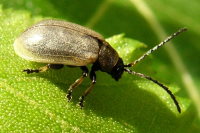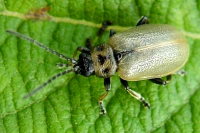Phylum Arthropoda (Arthropods) ➔ Subphylum Hexapoda (Hexapods) ➔ Class Insecta (Insects) ➔ Order Coleoptera (Beetles) ➔ Family Chrysomelidae (Leaf beetles)
Lochmaea caprea (Linnaeus, 1758)
Braungelber Weidenblattkäfer Willow Leaf Beetle
Synonyms and other combinations:
Chrysomela caprea Linnaeus, 1758 | Galeruca livida Fourcroy, 1785 |
Classification:
Lochmaea caprea belongs to the subfamily Galerucinae, tribe Galerucini.Distribution:
Temperate Palearctic: Morocco, Europe, east to Japan, south to Turkey and central China.Habitat:
Mainly wetlands.Description:
Length 4 - 6 mm; head completely black with the exception of the jaws and dull and wrinkled except for the forehead cusps; antennae slender, segment 3 much longer than 4; forehead with 2 flat humps; wing covers brownish-yellow, densely dotted and hairless, suture seam not darkened, epipleura almost hairless.Similar species:
The Heather Beetle Lochmaea suturalis living on brush heather (Calluna vulgaris) is very similar to Lochmaea caprea. It has slightly finer and denser dotted wing covers, which often have a dark suture.The Hawthorn Leaf Beetle Lochmaea crataegi has shorter and thicker antennae and shorter reddish brown wing covers with hairy epipleura.
Biology:
The adults of the Willow Leaf Beetle Lochmaea caprea can be found outdoors from April to September. The species mainly lives on different willow species, e.g. on goat willow (Salix caprea), grey willow (Salix cinerea) or white willow (Salix alba), as well as on birches (Betula) and more rarely on poplars (Populus).From April the beetles leave their winter quarters and fly to their forage plants. They sit on the upper side of the leaves and feed holes into the leaves. After mating, the females lay their eggs in small lumps on the ground below the forage plant. 3 - 4 weeks later the larvae hatch, climb onto their host plants and start eating at the undersides of the leaves. After 3 larval stages, pupation takes place in an earth cave in the upper soil layer. The new generation hatches at the end of August. After a short maturation feeding period the beetles go into hibernation in September.
References, further reading, links:
- Rheinheimer, Joachim, & Hassler, Michael: Die Blattkäfer Baden-Württembergs, 2018, 928 pages, Kleinsteuber Books (Karlsruhe), ISBN 978-3-9818110-2-5
- Arved Lompe: Die Käfer Europas - Ein Bestimmungswerk im Internet
- Agelastica alni
- Altica sp.
- Aphthona nonstriata
- Bromius obscurus
- Bruchus rufimanus
- Bruchus sp.
- Cassida nebulosa
- Cassida rubiginosa
- Cassida sp.
- Cassida stigmatica
- Cassida vibex
- Cassida vibex/bergeali
- Cassida viridis
- Chrysolina fastuosa
- Chrysolina haemoptera
- Chrysolina hyperici
- Chrysolina lucidicollis
- Chrysolina oricalcia
- Chrysolina sp.
- Chrysolina sturmi
- Chrysolina varians
- Chrysomela populi
- Chrysomela tremula
- Chrysomela vigintipunctata
- Clytra laeviuscula
- Clytra quadripunctata
- Coptocephala sp.
- Crepidodera aurata
- Crepidodera aurea
- Crepidodera fulvicornis
- Crioceris duodecimpunctata
- Cryptocephalinae sp.
- Cryptocephalus moraei
- Cryptocephalus nitidus
- Cryptocephalus pusillus
- Cryptocephalus sp.
- Donacia bicolora
- Donacia cinerea
- Donacia marginata
- Donacia versicolorea
- Galeruca tanaceti
- Galerucella s.l.
- Gastrophysa viridula
- Gonioctena decemnotata
- Gonioctena quinquepunctata
- Gonioctena quinquepunctata/intermedia
- Gonioctena sp.
- Gonioctena viminalis
- Lema cyanella
- Leptinotarsa decemlineata
- Lilioceris lilii
- Lochmaea caprea
- Neocrepidodera ferruginea
- Neocrepidodera sp.
- Oulema melanopus/duftschmidi
- Oulema obscura
- Pachybrachis sp.
- Phratora sp.
- Phratora vitellinae
- Phyllobrotica quadrimaculata
- Phyllotreta armoraciae
- Phyllotreta nemorum
- Phyllotreta vittula
- Plagiodera versicolora
- Plagiosterna aenea
- Plateumaris sp.
- Podagrica fuscicornis
- Psylliodes sp.
- Pyrrhalta viburni
- Sphaeroderma sp.
- Xanthogaleruca luteola



